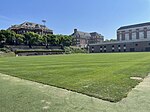University of Dayton Ghetto

The University of Dayton Ghetto, officially the Student Neighborhood, located in Dayton, Ohio, is home to upperclassmen at the University of Dayton (UD). Housing in "the Ghetto" is leased in an arrangement that resembles both traditional university housing and a landlord/tenant relationship. Tracing its history back to the 1870s, the neighborhood now includes more than 200 university-owned houses as well as landlord-owned houses, high-density housing and gathering spaces. With the inclusion of Holy Angels and The Darkside, or officially "the North Student Neighborhood", two smaller neighborhoods the university owns property in, there are more than 400 houses currently used as student residential space. Because of the area's age, the university has been engaged in a program to renovate and update the houses, and several additional changes to the neighborhood are expected in the coming years as part of the university's Master Plan.
Excerpt from the Wikipedia article University of Dayton Ghetto (License: CC BY-SA 3.0, Authors, Images).University of Dayton Ghetto
Firwood Drive, Dayton
Geographical coordinates (GPS) Address Nearby Places Show on map
Geographical coordinates (GPS)
| Latitude | Longitude |
|---|---|
| N 39.735 ° | E -84.176666666667 ° |
Address
University of Dayton
Firwood Drive
45419 Dayton
Ohio, United States
Open on Google Maps





